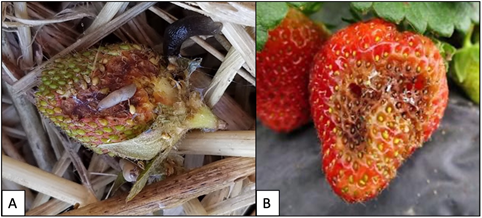Slugs seek shelter during the day to avoid desiccation and tend to be nocturnal, so visually inspecting at night or on cool, moist, and overcast mornings increases the chance of finding them. Traps made of roofing shingles, burlap sacks, or wet boards that provide shelter can be placed to attract slugs and checked in the morning. Additionally, cups containing beer or a yeast and sugar solution may trap slugs, but must be placed so the rim is at ground level.
Sap beetles are small, burrow into fruit, and quickly scatter when disturbed. To monitor sap beetles, place bucket traps baited with food odors (fermenting fruit or bread dough) along wooded edges near fields before fruit ripening. Bucket traps intercept sap beetle adults as they migrate into fields from overwintering sites.
Management
To reduce slug populations, remove potential slug habitats including debris, rocks, weeds, and logs and maintain adequate, but not excessive irrigation. Many natural enemies, such as ground beetles and spiders, feed on slugs, and avoiding broad-spectrum insecticides can help support their activity. The only chemical options for slugs are molluscicidal baits, such as metaldehyde (Deadline® M-Ps) and iron phosphate (Ferroxx® AQ, Sluggo®).
Overripe fruit and residue attract sap beetles to fields and serve as feeding and breeding sites. Sanitation practices such as harvesting frequently, removing overripe fruit, and renovating plantings immediately after the harvest season can reduce sap beetle populations. Biological control of sap beetle has been explored, but its efficacy in our area is unknown. On their own, insecticides are not highly effective against strawberry sap beetles because beetles and larvae are usually protected inside and under fruit. Multiple insecticide modes of action are recommended for sap beetles including pyrethroids (Group 3, Danitol®, Brigade®), neonicotinoids (Group 4A, Assail®), and benzoylureas (Group 15, Rimon®). Rimon® is only effective against sap beetle larvae and should not be used until after beetles are active in the field; however, in growing regions that are further south where other species of sap beetles are common this larval control can be beneficial and Rimon® is often recommended as a rotational or tank mix partner. Before applying pesticides, read and follow the safety information and application instructions on the label, the label is the law. For further information about recommended products for each pest, consult the Mid-Atlantic Berry Guide https://extension.psu.edu/the-mid-atlantic-berry-guide-for-commercial-growers
Recommended Other Resources:
This article appears in the May 2022, Volume 13, Issue 2 of the Vegetable and Fruit News

